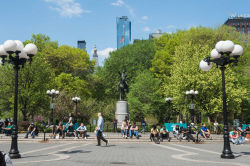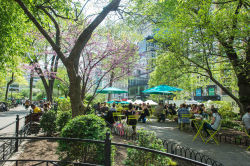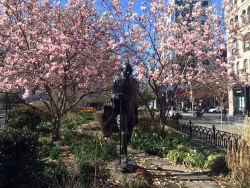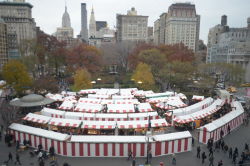Union Square Park
Union Square
For nearly 170 years Union Square has been a gathering place—for commerce, for entertainment, for labor and political events, and for recreation. The park owes its name to its location at the intersection—or union—of two major roads in New York City, Bloomingdale Road (now Broadway) and Bowery Road (now Fourth Avenue). When the Commissioner’s Plan, the famous gridiron of Manhattan streets and avenues, was projected in 1807, the former potter’s field at this intersection was designated as Union Place. The site was authorized by the State Legislature as a public place in 1831 and acquired by the City of New York in 1833.
On July 19, 1839 Union Square opened to the public. Its paths, situated among lushly planted grounds, were inspired by the fashionable residential squares of London. The design emphasized the park’s oval shape (enclosed by an iron picket fence) and focused on a large central fountain, which was installed for the opening of the Croton Aqueduct in 1842. As New York City’s downtown expanded northward, Union Square became an important commercial and residential center. Around its borders sprang up houses, hotels, stores, banks, offices, manufacturing establishments, Tammany Hall, and a variety of cultural facilities, including music auditoria, theatres, and lecture halls. The grounds of Union Square have frequently served as a choice location for public meetings, including parades, labor protests, political rallies, and official celebrations such as the Great Metropolitan Fair of the U.S. Sanitary Commission in 1864.
In 1871 Parks Engineer in Chief M.A. Kellogg and Acting Landscape Gardener E.A. Pollard collaborated on a new plan for Union Square. A year later the park was redesigned by landscape architects Frederick Law Olmsted and Calvert Vaux. They removed the enclosing fence and hedge, planted a variety of hardy trees, widened the sidewalks, and created a muster ground and reviewing stand "to meet the public requirement of mass-meetings."
Ten years later, Union Square played a central role in the first Labor Day celebration. On September 5, 1882, a crowd of at least 10,000 workers paraded up Broadway and filed past the reviewing stand at Union Square. As the procession passed the stand, Robert Price of Lonaconing, Maryland said to Richard Griffiths, the General Worthy Foreman of the Knights of Labor, "This is Labor Day in earnest, Uncle Dick." On June 28, 1894, President Grover Cleveland signed the legislation which made Labor Day a national holiday.
In 1928-29 Union Square was completely demolished to accommodate a new underground concourse for the subway. Alterations made in the 1920s and 1930s included the straightening of park paths, the construction of a colonnaded pavilion, and the dedication of the Independence (Charles F. Murphy Memorial) Flagstaff (1926, sculpted by Anthony de Francisci). Earlier monuments in the park include George Washington (1856, Henry Kirke Brown), Abraham Lincoln (1868, also Brown), Marquis de Lafayette (1873, by Frédéric-Auguste Bartholdi), and the James Fountain (1881, by Karl Adolph Donndorf). Since 1976 the Union Square Greenmarket has served as a local landmark, offering a cornucopia of fresh food and plants on the north side of the park, where a flower market flourished over a century ago.
Threatened by general misuse, deterioration, and the presence of drug dealers in the 1970s, Union Square has recently undergone a dramatic transformation. In 1985 major renovations under Mayor Edward I. Koch included creating a new plaza at the south end of the park, relocating paths to make the park more accessible, planting a central lawn, and installing new lighting and two subway kiosks. In 1986 a monument to Indian political leader and social reformer Mohandas Gandhi (1986, by Kantilal B. Patel) was dedicated on a traffic island southwest of the main park. Two new playgrounds were constructed in 1993-94, and a restaurant opened in the sunken courtyard outside the pavilion in 1994.
In 1997 the United States Department of the Interior designated Union Square Park as a National Historic Landmark because of its significance in American labor history. Plans are underway to extend the park line south 14th Street, and to incorporate in the park the traffic island on which the Gandhi statue now stands.
Check out your park's Vital Signs
Clean & Safe
Green & Resilient
Empowered & Engaged Users
Share your feedback or learn more about how this park is part of a
Vital Park System




